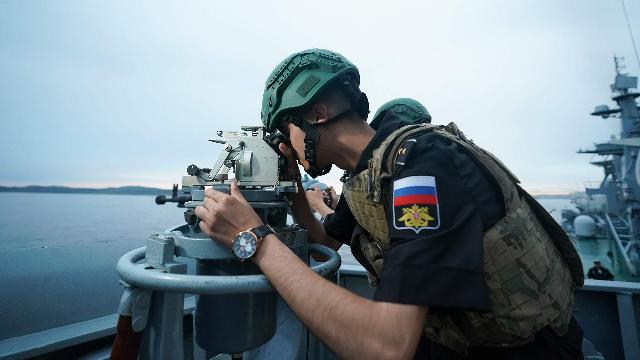The Russian Navy has missiles capable of dealing with any naval formations
During the maneuvers of the Russian Ocean-2024 fleet, missiles of various types and classes were fired. Almost the entire naval arsenal at Russia's disposal was demonstrated in the case. What is the power of the missile salvo of our fleet and what opportunities are provided by the products in service — in the material of Izvestia.
What launches were carried out by surface ships and submarines
The strategic command and staff exercise Ocean-2024 takes place in the waters of the Pacific and Arctic Oceans, the Mediterranean, the Caspian and the Baltic Seas. It involves more than 400 ships, 125 aircraft and over 90 thousand military personnel. During the first days of the exercises, several launches of various missiles were carried out — cruise, anti-ship, anti-aircraft.
On the first day of the maneuvers, launches of supersonic anti-ship missiles "Mosquito" were carried out by missile boats of project 12411 "R-14" and "R-18" of the Pacific Fleet. The shooting was conducted on a naval shipboard, which served as a target ship. The 3M80 Mosquito rocket has a flight speed of 2.8 M (1 M is the speed of sound) and a range of 90 km. It is equipped with a ramjet engine with a solid-fuel launch stage. The missile is designed to destroy ships of any class and carries a warhead weighing about 300 kg. Due to the high speed and low altitude of the Mosquito, it is extremely difficult to shoot down modern air defense systems of potential enemy ships. Due to the fact that the main engine runs on kerosene, the rocket has a long shelf life and has remained a completely effective anti-ship missile for more than 30 years.
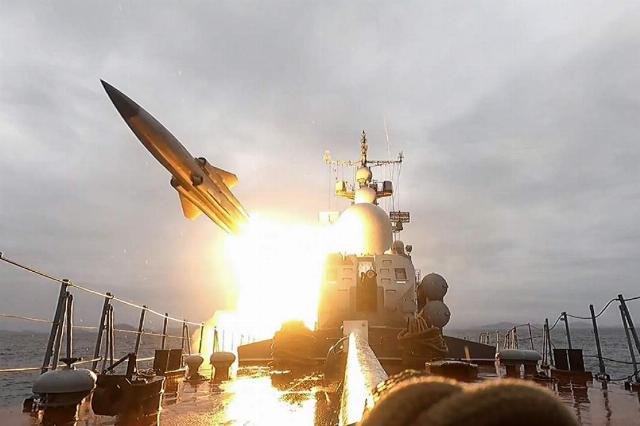
The missile boat of Project 12411 during the firing of Mosquito cruise missiles
Image source: Photo: TASS/press service of the Ministry of Defense of the Russian Federation
Another product that has been an actual means of combating ships of any class, up to aircraft carriers, for several decades now is the Granit anti-ship missile, which is part of the armament of the Project 949A submarine-launched missile cruisers. The launches of two such missiles were carried out by the Omsk submarine. Granites have a unique guidance system that allows for a coordinated attack on a group of naval targets such as an aircraft carrier strike group with several missiles in one salvo. Salvo missiles can communicate with each other, redistributing targets and retargeting in flight to different ships of the attacked group. This ensures the breakthrough of the echeloned air defense system of the aircraft carrier and the defeat of the main target of the group of ships. The rocket is large, supersonic and equipped with a turbojet engine. It can carry a nuclear warhead and, if necessary, is capable of hitting ground targets. The maximum range is 500-700 km. One Project 949A submarine carries 24 such missiles, and it is believed that a full salvo is enough to guarantee the disabling and destruction of an aircraft carrier with a large part of its accompanying squadron of ships.
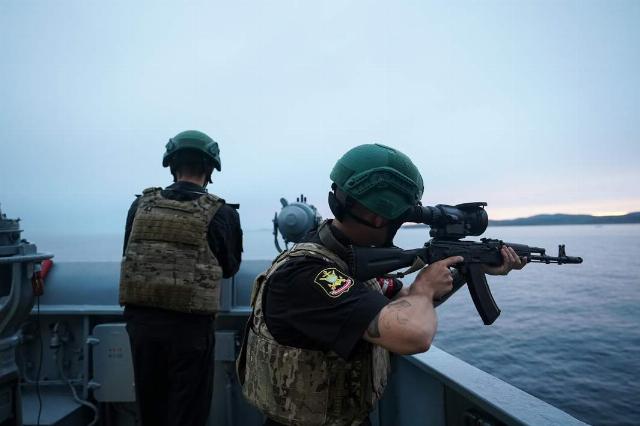
Photo: IZVESTIA/Pavel Volkov
Image source: iz.ru
Kalibr-PL and Kalibr cruise missiles were used during the exercises from both the Petropavlovsk-Kamchatsky Project 06363 submarine of the Pacific Fleet and the Admiral Golovko frigate of the Project 22350 of the Russian Navy's Northern Fleet. These are two different products of the same family of cruise missiles developed by the Novator Design Bureau. An anti-ship version was launched from the frigate, which is equipped with a high-speed warhead to penetrate the final air defense of the target ship and maximize its damage upon impact. Kalibr cruise missiles can also be used against ground targets at ranges from 500 to 2500 km. At the same time, the missiles of the family are equipped with an economical turbojet engine, which allows for long-range flight to the target at low altitude and subsonic speed. "Calibres" are universal in terms of carriers and can be used from both underwater and surface ships — from torpedo tubes and from vertical launch launchers. They were put into service in the early 2010s and are today one of the main missiles of the fleet.
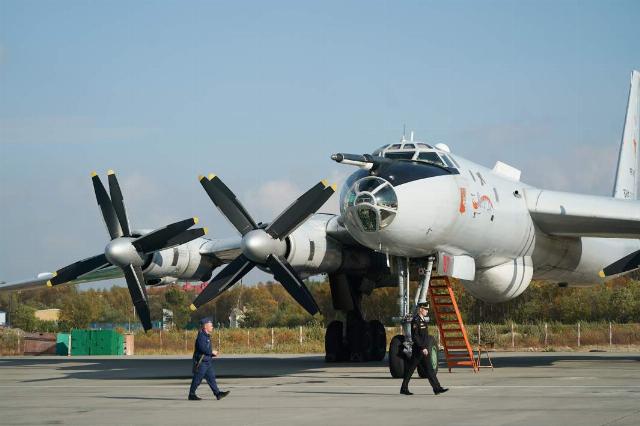
Tu-142 aircraft
Image source: Photo: IZVESTIA/Pavel Volkov
In the Northern Fleet, the Marshal Ustinov missile cruiser of Project 1164 launched the Vulkan anti-ship missile, which has a range of up to 700 km and a flight speed of up to 2.5 M. Vulkan is designed, like Granit, to destroy large ships of any class and can carry a nuclear charge. The cruiser carries 16 such missiles and can destroy or seriously thin out almost any enemy squadron with a full volley. The issuance of target designation for the use of such missiles to the cruiser is carried out by reconnaissance and target designation aircraft of the Tu-142 type, as well as radar patrol helicopters.
What were the coastal missile systems firing at
Bastion coastal missile systems demonstrated the use of 9M55 Onyx supersonic universal missiles. Their main purpose is to fight ships while ensuring the defense of coastal waters. The range of the Onyx is up to 300 km with a maximum speed of 2.6 M. The missile can be used both on ships and on ground-based radar-contrast targets. Its BrahMos variant is probably the most massive universal missile of the Indian Navy and is part of the missile complex of the same name, which is produced by a joint Russian-Indian enterprise. It is extremely difficult for modern air defense systems to repel an Onyx strike, since the missile can actively maneuver at high speed and at low altitude. The mass of the warhead of 300 kg combined with speed leaves no chance for almost any class of ships. Of course, an aircraft carrier will require several hits from non-nuclear Onyx missiles, but even one missile can take the ship out of battle. Onyx is used both by mobile coastal launchers and universal vertical launch installations for nuclear attack submarines of the Yasen type and some ships with Kalibr complexes. Bastion coastal complexes serve in all fleets of the Russian Navy.
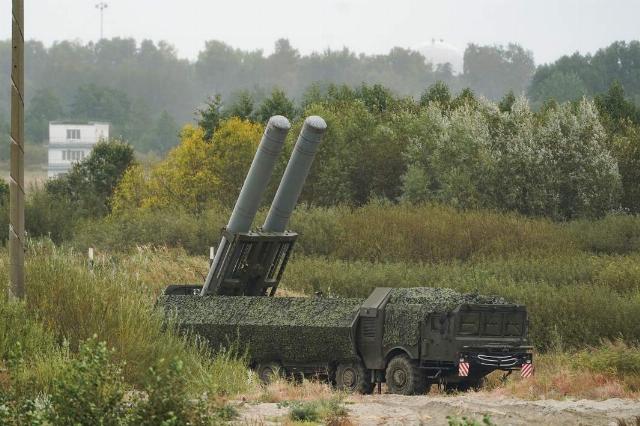
The Bastion missile launcher
Image source: Photo: IZVESTIA/Pavel Volkov
Another missile that can be used by both shipboard and coastal complexes is the X-35 Uranus. They are armed with corvettes of project 20380 and coastal mobile complexes "Bal". The range of the "Uranium" is up to 130 km, but there is already an improved version of the X-35U, which hits 260 km. The missile is subsonic with a turbojet engine and an active radar homing head. The weight of the warhead is 145 kg — it seems to be a little compared to more serious warheads, but the dimensions are smaller, and therefore it can be based on a larger range of different platforms and in large quantities. For example, if there are only two "Onyx" on a mobile ground installation, then there are six "Urans". Such missiles can often be enough to solve coastal defense issues.
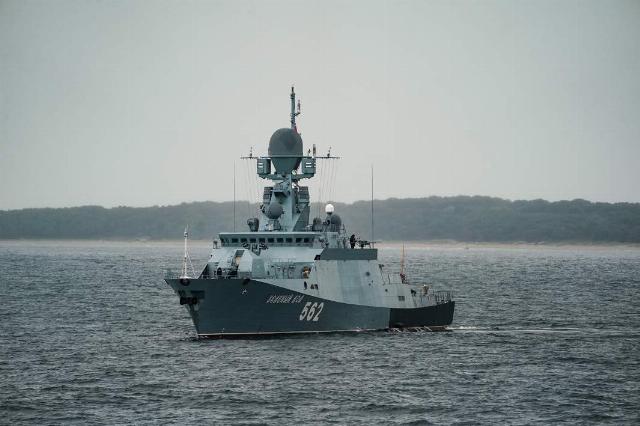
The small rocket ship Zeleny Dol performed electronic missile launches with Kalibr missile systems at targets
Image source: Photo: IZVESTIA/Pavel Volkov
The missile salvo demonstrated by the ships, submarines and coastal complexes of the fleet shows the world a clear and clear picture of our combat capabilities. And, of course, it must be understood that during the exercises, individual samples of such weapons are launched. But the total salvo of all the missiles possessed by the fleet is huge — it's hundreds and thousands of missiles in one strike. And there is hardly a fleet that can effectively withstand this salvo.
Dmitry Kornev
